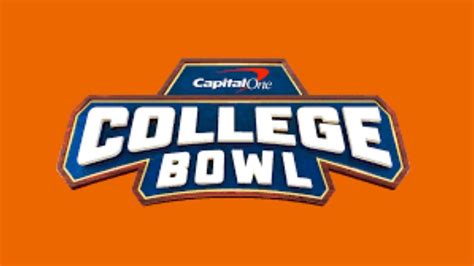Review: Capital One College Bowl

G.E. College Bowl was a staple of broadcast television for more than a decade (1959 to 1970). Some time after College Bowl went off network television, College Bowl Company Incorporated (CBI), the company that ran College Bowl, organized a Campus Program, an annual competition which ran on college campuses from 1977 to 2008. Some of those completitions also got national airplay, including the national semifinals and finals in 1984 on NBC with Pat Sajak as host. Some players criticized the game's excessive bureaucratic rules, the question quality (or lack thereof), and organizational incompetence -- and in response they organized rival quiz tournaments like Academic Competition Foundation/Federation (ACF), National Academic Quiz Tournaments (NAQT), and Testing Recall About Strange Happenings (TRASH).
I played in the College Bowl campus program when I was in college and graduate school. I was also very active in tournament play in the non-CBI quizbowl circuit, and on the de facto quizbowl Usenet group, alt.college.college-bowl, and I helped contribute to the early years of NAQT as a question writer and editor. NAQT has since grown to be a dominant force in quizdom, and with the end of the College Bowl campus competitions in 2008 to the glee of much of the circuit, it seemed everyone else had moved on as well. What's more, CBI lost some of their main organizers, including the game's creator Don Reid and longtime CBI organizer Mary Oberembt.
So imagine my surprise in early 2021 when I hear word that from out of nowhere College Bowl would make a return to network television for the first time in 37 years, with Capital One instead of General Electric as your namesake sponsor and with Peyton Manning as host for some reason. Audience sizes for network television are mired in a steady and probably irreversible decline, so there's a growing need for low-cost programming on networks. Game shows as a genre have lasted as long as they have precisely for that reason -- there's a lot less cost and overhead (the host's salary is probably the biggest expense), and a big reason why a lot of long-dormant game show properties have found new life in recent years (just look at ABC's lineup). College Bowl has an additional appeal in that the main competitors are competing not for actual cash but rather for scholarships.
I was expecting Capital One College Bowl to be a pale imitation of the game I knew and loved during my college and grad school years, and I was not disappointed. The format of the game I played was that two teams of four players each answered questions in two halves (sometimes on the clock, sometimes not), with "tossup" questions you could interrupt anytime with clues ordered from most difficult to least difficult and "bonus" questions that were a mix of formats. The game I saw on NBC in 2021 consisted of two teams of three players in three rounds -- two rounds of questions with no tapering, no mid-question interruption, and chosen from a list of categories(?!); and a third-round rapid-fire round called the Two-Minute Drill (don't tell ESPN about your clever name!) where teams answer as many questions as they can in two minutes.
The format change in College Bowl is emblematic of the format change in CBI-organized games more generally. In 2005, CBI organized the Zain Africa Challenge, a quiz tournament played among African college-age students and created by Don Reid's son Richard; the game used this new format (three players per team, two "face-off" rounds, a third "ultimate challenge" round). In 2011, the format of Zain Africa Challenge was used for another CBI-organized quiz tournament, the Honda Campus All-Star Challenge. And now, in 2021, the same format has been brought (with slight tweaks) to the original College Bowl.
Even though I don't prefer the changed format, I can live with format changes, if the game is improved. But with this game, it's not, and instead there's much to kvetch about: The questions are too easy. Most of the game's aggregate point total comes via the two-minute drill -- which is exciting to watch, sure, but more than 85% of all the points in the game are scored in just four minutes of the half-hour of the game, rendering most of the rest of the game superfluous. And worse, we're subjected to what passes for repartee between Peyton and his brother Cooper whose main job is to provide "comedy" "relief" but is really just to eat up airtime. Spare me the jokes please; if I want to laugh, I'll watch an episode of 30 Rock or Schitt's Creek or a show that's, you know, funny. Watching (or playing) College Bowl, I want to learn, to have my mind debauched by learning, to borrow a line from Steven Pinker's The Language Instinct.
Which leads to another considerable problem with the questions in Capital One College Bowl -- they're as dull as hell. There's no tapering -- no ordering of clues from most difficult to least difficult. And while you don't need to have tapering to write interesting questions about interesting things, and while questions that do use tapering can still be as dry as a desert rock, at least you stand a better chance to have more interesting -- or any interesting -- questions with tapering. Here we have the worst of both worlds -- no tapering, and the questions are by and large lifeless. Games of knowledge should make you think, tweak your brain, make you say "Wow, that's neat!", introduce new things, broaden your horizons, be a mini-education unto themselves.
That's a tall order, and difficult to do under any circumstance. A good game of knowledge should do that as much as possible, and sadly, Capital One College Bowl doesn't do that at all.